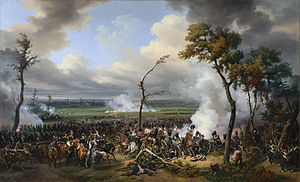Battle of Hanau
| Battle of Hanau | |||||||
|---|---|---|---|---|---|---|---|
| Part of the War of the Sixth Coalition | |||||||
 Horace Vernet's painting "Battle of Hanau", held at the National Gallery in London. This scene depicts the Austro-Bavarian cavalry charge on the French Grand Battery and the countercharge of Nansouty's French Guard cavalry. |
|||||||
|
|||||||
| Belligerents | |||||||
|
|
|
||||||
| Commanders and leaders | |||||||
|
|
|
||||||
| Strength | |||||||
| 17,000, 60 cannons | 43,000, 134 cannons | ||||||
| Casualties and losses | |||||||
| 4,500 dead and wounded 1,300 prisoners |
9,000 dead and wounded | ||||||
The Battle of Hanau was fought on (30 – 31 October 1813) between Karl Philipp von Wrede’s Austro-Bavarian corps and Napoleon's retreating French during the War of the Sixth Coalition.
Following Napoleon's defeat at the Battle of Leipzig earlier in October, Napoleon began to retreat from Germany into France and relative safety. Wrede attempted to block Napoleon’s line of retreat at Hanau on 30 October. Napoleon arrived at Hanau with reinforcements and defeated Wrede’s forces. On 31 October Hanau was in French control, opening Napoleon’s line of retreat.
The Battle of Hanau was a minor battle, but an important tactical victory allowing Napoleon’s army to retreat onto French soil to recover and face the invasion of France.
The Battle of Leipzig, the largest and bloodiest encounter of the Napoleonic Wars, began on 16 October 1813, raged for three days and ended with a decisive victory for the Sixth Coalition. Napoleon was forced to abandon central Germany to the coalition and hastily retreated westwards. His strategy was to regroup all his available forces on the shores of the Rhine, where his lines of communication would be shorter and his rear less likely to be threatened. The Emperor's concern was that his already battered army might be forced to fight against superior forces again, so he ordered that the retreat be carried out at great speed. Had the coalition managed to advance with more vigour in the days following the Battle of Leipzig, the already disorganised French army would probably have been destroyed, but the coalition armies themselves had suffered such high losses at Leipzig that they were in no position to launch an effective pursuit. With military action confined to secondary rearguard actions, Napoleon was able to install his headquarters at Erfurt on 23 October and began to reorganise his forces. On 26 October, he sent orders to the various corps, directing them to Frankfurt via Eisenach and Fulda. Their assigned destination was the city of Mainz, by the Rhine river.
...
Wikipedia
